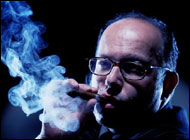People who smoke “lights” less likely to quit
The misconception that “light” cigarettes are safer than regular brands may be preventing some smokers from quitting altogether, a new study suggests.
Researchers found that among more than 12,000 current and former smokers, more than a third said they’d switched to light cigarettes for “health” reasons. And these smokers were only half as likely to kick the habit as those who stuck with regular cigarettes.
The findings, published online by the American Journal of Public Health, help validate the concern that many smokers may see light cigarettes as an alternative to quitting, said lead study author Dr. Hilary A. Tindle of the University of Pittsburgh School of Medicine.
Critics have long charged that cigarettes branded as “light,” “ultralight,” and “low-tar” dupe the public into thinking they carry fewer health risks, even though studies have shown light cigarettes to be as deadly as regulars.
Light cigarettes are designated as such because they deliver less nicotine and lower levels of toxic chemicals when the smoke is measured by a machine. In real life, however, smokers inhale comparable amounts of nicotine and tobacco chemicals regardless of the brand. 
Experts say that people who use lights may, for example, inhale more deeply to get more nicotine, or simply smoke more cigarettes.
While it’s clear that light cigarettes are not a healthier way to smoke, what’s been unclear is whether they may actually hinder some people from quitting, Tindle told Reuters Health. The current findings, she said, suggest that is the case - and also highlight the “still widespread misconception” that light cigarettes are less of a health threat.
The results are based on a federal health survey of more than 32,000 U.S. adults conducted in 2000. Of 12,285 current or former smokers, 37 percent said they had used light cigarettes specifically to reduce their health risks.
Extrapolated to the entire U.S. population, that figure represents more than 30 million smokers who may mistakenly believe they have lower odds of smoking-related ills, according to Tindle and her colleagues.
“Something needs to be done to correct people’s misconceptions,” Tindle said.
Public service campaigns could help drive the message home, she said, and doctors could stress the point that light cigarettes are no alternative to quitting when they counsel patients who smoke.
Pack labels could also carry more specific warnings about the health risks of lights, according to the researchers.
Since being introduced in the U.S. in the late 1960s, light cigarettes have grown to account for roughly 85 percent of cigarettes sales.
SOURCE: American Journal of Public Health, August 2006.
Revision date: June 20, 2011
Last revised: by Jorge P. Ribeiro, MD